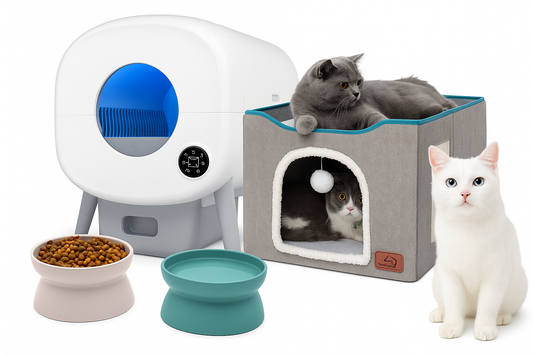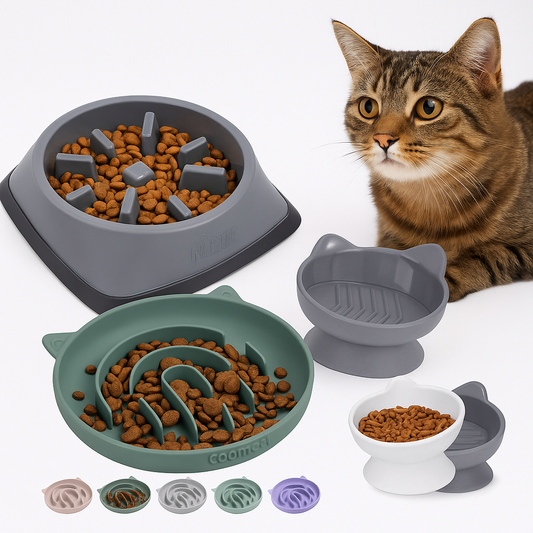
Common Cat Allergies (And What You Can Do About Them)
Cats might seem low-maintenance compared to dogs, but when allergies strike, they can turn into high-need patients fast. Itchy skin, hair loss, upset stomachs — allergies can cause a whole range of symptoms that are easy to miss or misdiagnose. Whether you're a new cat owner or you've been living with your feline for years, understanding common cat allergies and how to treat them can make a huge difference in your cat’s quality of life.
This guide breaks down the most common allergens, how to recognize the symptoms, and what steps you can take to bring your cat some relief — from vet-approved treatments to everyday changes you can make at home.
What Causes Allergies in Cats?

Allergies happen when your cat’s immune system overreacts to something that’s usually harmless — like pollen, food proteins, or flea saliva. The immune system thinks these substances are a threat, and it releases chemicals like histamines to try to fight them off. The result? Itchy skin, digestive issues, sneezing, and more.
Allergic reactions can be chronic or seasonal, mild or severe. The three most common cat allergies fall into these categories:
Source: 3 Most Common Cat Allergies & Their Signs: Vet-Approved Facts by Hepper Blog
1. Environmental Allergies (Atopic Dermatitis)
Environmental allergies are triggered by things in your cat’s surroundings. These could be natural allergens like pollen and mold, or synthetic ones like laundry detergent or air fresheners.
Common environmental allergens include:
- Grass, tree, and weed pollen (especially in spring and fall)
- Dust mites
- Mold spores
- Cigarette smoke
- Cleaning products
- Perfumes and air fresheners
- Certain fabrics or plastics
Unlike food or flea allergies, environmental allergies can be harder to isolate because they fluctuate with the seasons or the household environment. And if you’re wondering how to tell if your cat has allergies related to the environment, the symptoms usually show up on the skin or in the respiratory system.
- Symptoms to watch for:
- Excessive scratching or licking (especially around the head, neck, and paws)
- Red, irritated skin
- Bald spots or thinning fur
- Scabs or sores from over-grooming
- Watery eyes or sneezing
- Recurrent ear infections
What to do:
- See a vet to rule out other causes like parasites or infections.
- HEPA filters can help reduce airborne allergens in your home.
- Vacuum regularly using a pet-friendly vacuum with strong suction and a HEPA filter.
- Wipe down your cat’s coat and paws with a damp cloth after outdoor time to remove pollen and dust.
- Your vet might suggest antihistamines, steroids, or immunotherapy (allergy shots or drops) depending on the severity.
2. Flea Allergy Dermatitis
Even one flea bite can cause chaos if your cat is allergic to flea saliva. Flea allergy dermatitis (FAD) is one of the most common — and most frustrating — cat allergy symptoms to manage, because cats are such meticulous groomers. That means you might never actually see a flea.
Signs your cat has flea allergies:
- Sudden scratching or biting at the base of the tail
- Hair loss on the lower back or thighs
- Red, inflamed skin or scabs
- Restlessness or aggression from constant itching
- Tiny black specks in the fur (flea dirt)
What to do:
- Use year-round flea prevention, even for indoor cats. Ask your vet to recommend a product that’s safe and effective.
- Treat all pets in the household — fleas jump from one host to another easily.
- Vacuum carpets, furniture, and pet bedding regularly to remove eggs and larvae.
- Wash your cat’s bedding on hot every week until the infestation is gone.
- Severe reactions might require a short course of steroids or a medicated shampoo to calm inflammation.
Pro tip: If your cat’s scratching doesn’t stop even after flea treatment, it might be a combo allergy — like fleas and food.
Dealing with flea-related allergies? Flea bites are one of the most common allergy triggers in cats — but the right treatment can make a huge difference. We've rounded up the best options in our latest post: Top 10 Flea & Tick Treatments for Cats That Actually Work. From gentle topicals to fast-acting tablets, find a solution that helps your cat stay itch-free and fabulous.
3. Cat Food Allergies
Cats can develop sensitivities to ingredients in their food, just like people. And while true food allergies aren’t as common as environmental ones, they can still cause major discomfort — especially in the digestive tract and on the skin.
Common food allergens:
- Beef
- Chicken
- Fish
- Dairy
- Grains (less common, but some cats are sensitive)
- Artificial colors and preservatives
Cat food allergies symptoms:
- Chronic vomiting or diarrhea
- Itchy skin (especially face, ears, and neck)
- Hair loss or scabs
- Poor coat condition
- Frequent ear infections
- Flatulence or bloating
Food allergies can develop at any age, even if your cat has been eating the same diet for years. They often require some trial and error to diagnose, but once identified, they're usually manageable.
How to Tell If Your Cat Has Allergies: A Step-by-Step Approach

Because cat allergy symptoms often overlap with other issues — like parasites, infections, or behavioral grooming — the only way to know for sure is through observation and veterinary help.
Here’s a smart way to approach it:
Step 1: Track symptoms
Note when they appear, how severe they are, and if they’re seasonal or constant. Do they get worse after eating or going outside? This helps your vet narrow it down.
Step 2: Visit the vet
Your vet might do skin tests, blood tests, or food elimination trials. Sometimes it's a process of ruling things out.
Step 3: Elimination trials
If food allergies are suspected, your vet may recommend a limited ingredient diet or hypoallergenic formula for 8–12 weeks — no treats, no table scraps, no cheating. If symptoms clear up, you’ve likely found the trigger.
Step 4: Allergy testing
For environmental allergies, your vet may suggest intradermal (skin) testing or serum blood tests to pinpoint specific allergens. From there, allergy immunotherapy may be an option.
Treatment Options: What You Can Do
No matter what kind of allergy your cat has, the goal is to reduce exposure to the allergen and control symptoms. Here’s what you can do at home and in partnership with your vet:
General tips:
- Use hypoallergenic cleaning products and detergents.
- Switch to ceramic or stainless steel bowls — plastic can trap allergens.
- Keep your cat’s environment clean and free of dust, mold, and smoke.
- Bathe your cat with vet-approved shampoos if skin is irritated (ask first).
Medical treatments:
- Antihistamines: Some cats respond well to over-the-counter meds like chlorpheniramine or cetirizine — but only under vet supervision.
- Corticosteroids: Useful for short-term relief during flare-ups, but not ideal for long-term use.
- Cyclosporine: An immune-suppressing drug for cats with moderate to severe symptoms.
- Immunotherapy: Allergy shots or oral drops customized to your cat’s allergens — a long-term commitment, but the only treatment aimed at reducing the allergy itself.
Managing Long-Term Cat Allergies
Allergies can’t always be cured, but they can be managed. Once you understand what’s triggering your cat’s symptoms, you can create a plan that minimizes flare-ups and improves their comfort.
Ongoing care tips:
- Stick to a consistent flea prevention routine.
- Don’t switch foods without cause — sudden changes can trigger reactions.
- Monitor for new symptoms as your cat ages; allergies can develop over time.
- Partner with your vet to adjust treatments as needed.
Final Thoughts
Allergies can make your cat miserable — and leave you feeling helpless. But the good news is that most allergic cats can live full, comfortable lives with the right care. Whether your cat is reacting to food, fleas, or something in the air, understanding the cause is the first step toward relief.
If you’re still unsure how to tell if your cat has allergies, don’t guess. Schedule a vet visit, take notes, and be ready to try a few different approaches. With time and consistency, you’ll find what works.



